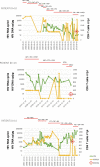Persistence of Unintegrated HIV DNA Associates With Ongoing NK Cell Activation and CD34+DNAM-1brightCXCR4+ Precursor Turnover in Vertically Infected Patients Despite Successful Antiretroviral Treatment
- PMID: 35558085
- PMCID: PMC9088003
- DOI: 10.3389/fimmu.2022.847816
Persistence of Unintegrated HIV DNA Associates With Ongoing NK Cell Activation and CD34+DNAM-1brightCXCR4+ Precursor Turnover in Vertically Infected Patients Despite Successful Antiretroviral Treatment
Abstract
The quantification of proviral DNA is raising interest in view of clinical management and functional HIV eradication. Measures of all unintegrated HIV DNA (uDNA) forms in infected reservoir cells provides information on recent replication events that is not found from other proviral DNA assays. To evaluate its actual relevance in a cohort of perinatally-infected adult HIV patients (PHIV), we studied how peripheral blood mononuclear cell uDNA levels correlated with total HIV DNA (tDNA) and with overall replication or innate immune control parameters including NK cell activation/exhaustion and lymphoid turnover. Twenty-two PHIV were included, with successfully controlled HIV (HIV RNA <50 copies/mL) on combined antiretroviral therapy for mean of 8.7 ± 3.9 years. uDNA accounted for 16 [5.2-83.5] copies/µg and was strongly correlated with tDNA (ρ=0.700, p=0.001). Flow cytometric analysis of peripheral NK cells showed that CD69 expression was directly correlated uDNA (p=0.0412), but not with tDNA. Interestingly, CD56-CD16+NK cells which include newly described inflammatory precursors and terminally differentiated cells were directly correlated with uDNA levels (p<0.001), but not with tDNA, and an inverse association was observed between the proportion of NKG2D+ NK cells and uDNA (ρ=-0.548, p=0.015). In addition, CD34+DNAM-1brightCXCR4+ inflammatory precursor frequency correlated directly with uDNA levels (ρ=0.579, p=0.0075). The frequencies of CD56-CD16+ and CD34+DNAM-1brightCXCR4+ cells maintained association with uDNA levels in a multivariable analysis (p=0.045 and p=0.168, respectively). Thus, control of HIV-1 reservoir in aviremic patients on ART is an active process associated with continuous NK cell intervention and turnover, even after many years of treatment. Quantification of linear and circular uDNA provides relevant information on the requirement for ongoing innate immune control in addition to ART, on recent replication history and may help stratify patients for functional HIV eradication protocols with targeted options.
Keywords: ART; CD34; HIV; inflammatory precursor; natural killer; reservoir; residual replication; unintegrated HIV-DNA.
Copyright © 2022 Taramasso, Bozzano, Casabianca, Orlandi, Bovis, Mora, Giacomini, Moretta, Magnani, Di Biagio and De Maria.
Conflict of interest statement
The authors declare that the research was conducted in the absence of any commercial or financial relationships that could be construed as a potential conflict of interest.
Figures





Similar articles
-
A comparative analysis of unintegrated HIV-1 DNA measurement as a potential biomarker of the cellular reservoir in the blood of patients controlling and non-controlling viral replication.J Transl Med. 2020 May 19;18(1):204. doi: 10.1186/s12967-020-02368-y. J Transl Med. 2020. PMID: 32429953 Free PMC article.
-
Timing of Antiretroviral Therapy Initiation Determines Rectal Natural Killer Cell Populations.AIDS Res Hum Retroviruses. 2020 Apr;36(4):314-323. doi: 10.1089/AID.2019.0225. Epub 2020 Jan 22. AIDS Res Hum Retroviruses. 2020. PMID: 31838858 Free PMC article.
-
HIV-1 latency and virus production from unintegrated genomes following direct infection of resting CD4 T cells.Retrovirology. 2016 Jan 5;13:1. doi: 10.1186/s12977-015-0234-9. Retrovirology. 2016. PMID: 26728316 Free PMC article.
-
The role of integration and clonal expansion in HIV infection: live long and prosper.Retrovirology. 2018 Oct 23;15(1):71. doi: 10.1186/s12977-018-0448-8. Retrovirology. 2018. PMID: 30352600 Free PMC article. Review.
-
Episomal HIV-1 DNA and its relationship to other markers of HIV-1 persistence.Retrovirology. 2018 Jan 30;15(1):15. doi: 10.1186/s12977-018-0398-1. Retrovirology. 2018. PMID: 29378611 Free PMC article. Review.
Cited by
-
CD34+DNAM-1brightCXCR4+ haemopoietic precursors circulate after chemotherapy, seed lung tissue and generate functional innate-like T cells and NK cells.Front Immunol. 2024 Feb 8;15:1332781. doi: 10.3389/fimmu.2024.1332781. eCollection 2024. Front Immunol. 2024. PMID: 38390333 Free PMC article.
-
Primary HIV infection features colonic damage and neutrophil inflammation yet containment of microbial translocation.AIDS. 2024 Apr 1;38(5):623-632. doi: 10.1097/QAD.0000000000003799. Epub 2023 Dec 4. AIDS. 2024. PMID: 38016163 Free PMC article.
References
Publication types
MeSH terms
Substances
LinkOut - more resources
Full Text Sources
Medical
Research Materials

